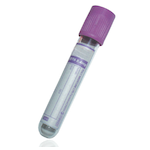Suitable Specimen Types
- EDTA Plasma
Specimen Transport
Frozen to referral labSample Processing in Laboratory
transfer frozen to referral labSample Preparation
EDTA plasma. Sample should be separated within 30 mins of collection and stored at -20 ºCTurnaround Time
21 daysSample Stability
-20 ºCChromogranin A
General Information
Chromogranin A (CgA) is a protein found in and released from neuroendocrine cells. Neuroendocrine cells, and the endocrine system glands that they are found in, can give rise to a variety of tumours, both benign and malignant. They include carcinoid tumours, phaeochromocytomas, insulinomas, small cell lung cancers, neuroblastomas, and other neuroendocrine tumours. Many of these tumours release large quantities of hormones - such as serotonin, catecholamines, or insulin – continuously or intermittently, causing symptoms characteristic for that tumour. However, some neuroendocrine tumours do not release the expected hormones. In either case, neuroendocrine tumours are frequently associated with increased concentrations of CgA.
Sensitivity for phaeochromocytoma is variously reported as in the order of 80% with a specificity of 100%. Serum concentrations show a strong correlation with tumour mass within the individual patient, and can thus be used for monitoring the response to treatment. The periodic estimation of chromogranin A can be used in screening families of individuals with Von Hippel-Lindau.
Chromogranin A should not be used as a first line investigation for either phaeochromocytoma or carcinoid. Instead, urinary catecholamines and metanephrines should be used for phaeochromocytoma while urinary 5HIAA should be used for carcinoid. Please see the relevent webpages for further information.
Patient Preparation
Please note, Chromogranin A may be falsely elevated in patients taking Proton-pump inhibitors (PPIs, e.g. omeprazole). If possible, these medications should be discontinued for at least 2 weeks prior to the sample being collected. If treatment must be continued, H2 receptor antagonists (e.g. Ranitidine) may be used as these only have modest effects on Chromogranin A concentrations.
Notes
As of 1/12/2023 analysis will be performed at a different referral laboratory. Please note chromogranin A will now be measured in pmol/L rather than nmol/L as previously. Results for this analysis are not comparable between the old and new test. Please contact the duty biochemist to discuss if required (bleep 2506).
Reference Range
<6 nmol/L (Provided by reference laboratory)
As of 1/12/2023 analysis will be performed at Charing Cross laboratory and the reference range will be < 60pmol/L. **PLEASE NOTE DIFFERENT UNITS**
Specifications
- EQA Status: IQC only
